
Score breakdown
Things we like
- Boosted EV-only range
- No compromise on boot space or towing ability
- Efficiency gains over petrol Outlander
- Polished and sophisticated powertrain
Not so much
- Price premium over petrol versions
- Ride can feel harsh over sharp bumps
- No spare tyre
Mitsubishi prides itself on being a plug-in pioneer. The previous Outlander PHEV wasn’t only one of the first plug-in hybrid family SUVs to hit the market, but it still holds the title as the world’s most popular plug-in.
Since it was introduced about a decade ago, Mitsubishi has sold more than 300,000 of these things.
Now, though, we have an all-new Outlander PHEV and it’s a significant improvement. EV-only range is up, there’s more performance on tap and unlike the previous model, which was only available as a five-seater, this time around you can opt for a PHEV that has a third row.
There’s no sacrifice in boot space, either, or towing capacity. The PHEV retains the same 485L boot and 1600kg braked towing capacity as the rest of the Outlander range. Win.
Predictably, the downside is you’ll need to pay for the privilege. The plug-in powertrain is available in nearly every trim level across the mode range but compared with a petrol-powered Outlander, the PHEV is at least $16,000 more expensive. Question is, is it worth it?
After all, $16,000 buys a lot of petrol… But as we’ll discover, the Outlander PHEV’s appeal stretches beyond its ability to simply save you cash at the bowser.
UPDATE: Outlander Range Review
Looking for more detail on the wider Outlander line-up? See our full Outlander range review at the link below!
How much is it and what do you get?
The basics
| Body | 5-door, 7-seat SUV |
|---|---|
| Power | 185kW |
| Torque | 450Nm |
| Transmission | Single-speed reduction |
| Drive | All-wheel drive |
| Fuel consumption | 1.5L/100km |
| Price | $68,490 |
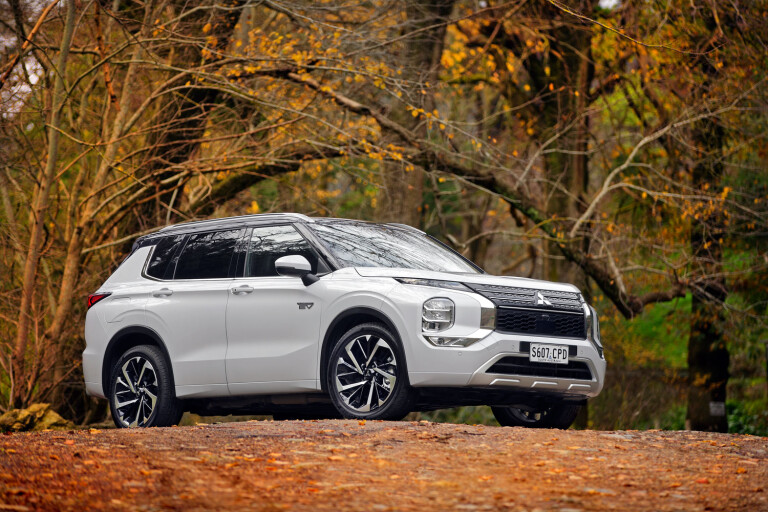
You can slip into a new-generation Outlander PHEV for $54,490 before on-road costs. That outlay scores you an entry-level ES five-seater and prices rise incrementally from there.
You can slip into a new-generation Outlander PHEV for $54,490 before on-road costs. That outlay scores you an entry-level ES five-seater and prices rise incrementally from there.
A mid-spec Aspire (also only available with five seats) will set you back $60,990 while the flagship Exceed and Exceed Tourer models are $65,990 and $68,490 respectively (all before on-road costs).
Need seven seats? The two extra pews are only available in the two top-spec Exceed models.
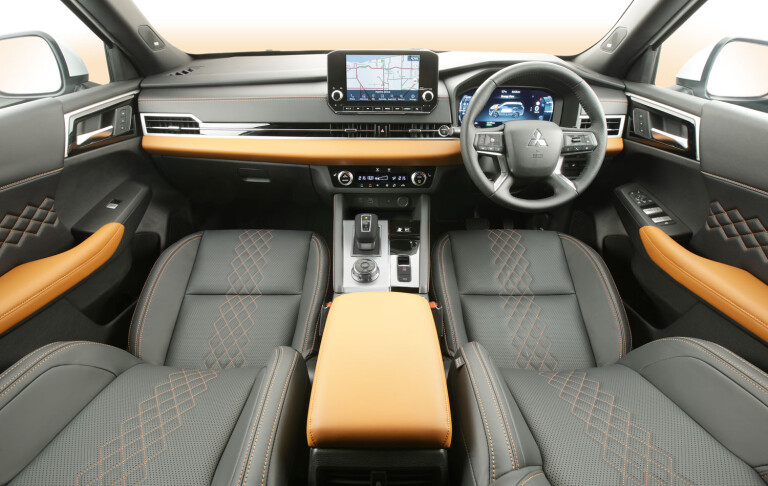
PHEV prices are roughly $16,000 more than an equivalent Outlander that’s powered by petrol alone. And you don’t score a host of additional equipment either. The only difference between a regular Outlander ES and an ES PHEV, for example, is the powertrain.
Happily, that powertrain is a vast improvement. The basic set-up is the same as before. Propulsion comes from the combination of a 2.4-litre four-cylinder petrol engine paired with an electric motor on either axle but those electric motors are all new.
They’re now more powerful, take up less room and are fed by a battery pack that has almost 50 per cent more capacity than before. The battery now measures 20kWh (that’s total capacity, meaning the useable capacity is slightly smaller) and the EV-only range has lifted to 84km, which is a useful 30km increase over the old PHEV.
It’s also vastly superior to the Outlander’s primary mainstream rival, the Ford Escape plug-in hybrid, which can only travel 54km on electricity alone.
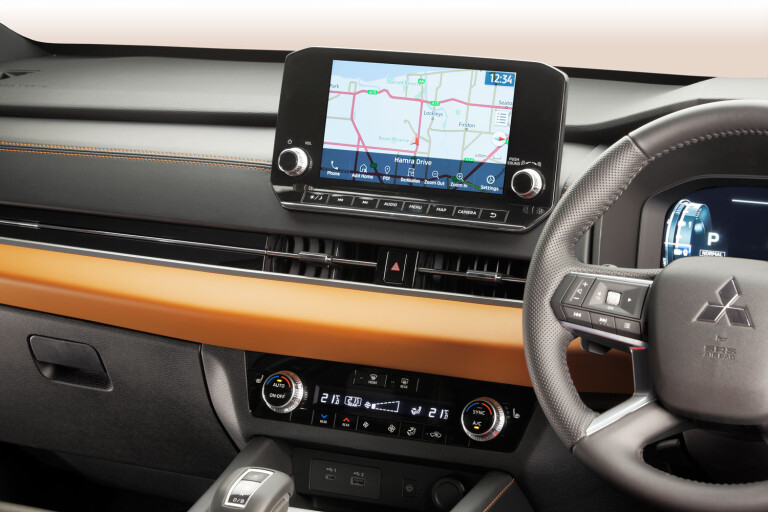
Slashing your fuel bill is a clear PHEV attraction but the Outlander PHEV’s powertrain also offers a desirable bump in performance.
Total combined outputs are 185kW/450Nm, which is an appreciable increase over petrol-powered models that produce 135kW/245Nm from a Nissan-sourced 2.5-litre four-cylinder.
There are other ways you can benefit from the larger battery capacity, too. Aspire model grades and above score two on-board power sockets that can power anything from laptops to household appliances, like coffee machines or blenders.
Just like the rest of the Outlander range, standard equipment levels are generous. Every PHEV model scores a comprehensive active safety suite (the full list is below), a configurable 12.3-inch digital instrument cluster, large 9.0-inch central touchscreen and wireless Apple CarPlay.

Android Auto is also standard but you need a wired connection, which remains a frustrating reality for several manufacturers in 2022.
The entry-level ES is targeted mostly at fleet buyers and its cloth seats, plastic steering wheel and 18-inch wheels certainly feel more hardwearing than premium.
Things take a noticeable step up in the mid-spec Aspire and Exceed trim levels, which Mitsubishi expects to account for 60 per cent of total sales.
Key additions for the Aspire include 20-inch alloys, a leather-trimmed steering wheel, heated front seats, head-up display, powered tailgate, wireless phone charging and twin USB charging points for second-row passengers.
The Exceed goes a step further with leather seats, a panoramic sunroof, rear window sunshades, tri-zone climate control and a nine-speaker Bose sound system. The flagship Exceed Tourer adds two-tone exterior paint, higher quality leather seats and a massage function for front passengers.

How do rivals compare on value?
Despite surging EV sales, the number of mainstream family SUVs available with a plug-in powertrain is actually fairly small. Ford offers the most logical rival to the Outlander PHEV and its Escape PHEV is also fresh to the market, having launched here in May 2022.
Unlike the Mitsubishi, however, it’s only available in a single ST-Line PHEV trim level and is priced at $53,440 before on-road costs. That means it’s roughly the same price as an entry-level Outlander PHEV but the Ford offers a richer spec for your cash.
No third row of seats, though, and unlike the all-wheel drive Outlander, the Ford is front-drive only. Plus it can’t match the Outlander for battery capacity or range. The Escape PHEV’s 14.4kWh battery offers 54km of pure EV propulsion.
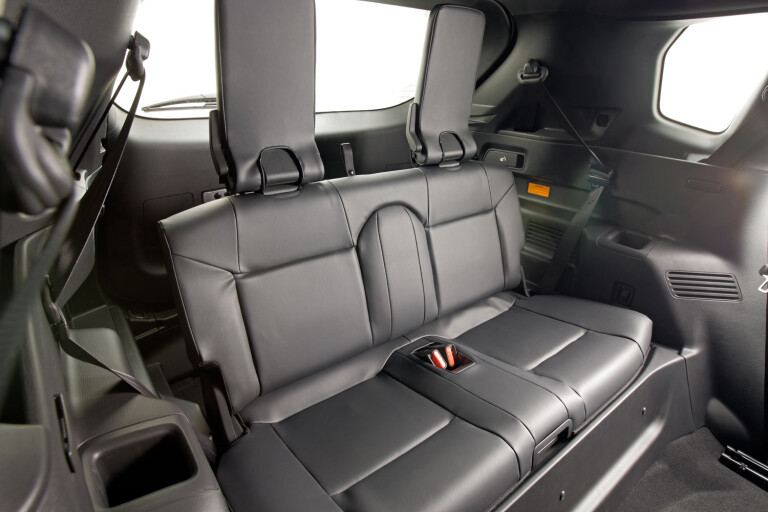
Another alternative worth considering is the Peugeot 3008 PHEV. It’s more expensive than the Outlander at $79,990 before on-road costs, and its cabin isn’t as roomy, but what the Pug interior lacks in room is more than made up for with style and luxury.
The 3008 PHEV is also seriously quick. It’ll rocket for 0-100km/h in a hot-hatch like 5.9 seconds.
Equally fast is the soon-to-arrive Mazda CX-60 plug-in hybrid. The CX-60 debuts an all-new platform and pairs a 2.5-litre petrol engine with an electric motor for outputs of 241kW/500Nm.
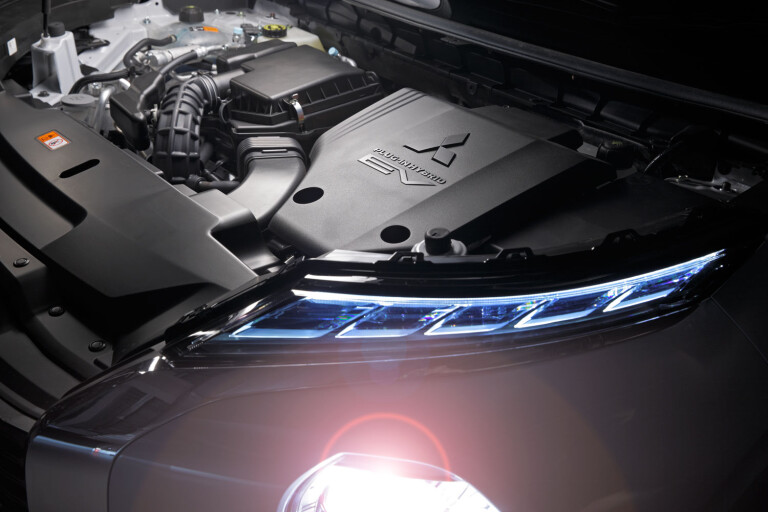
EV-only range is 60km but the Mazda’s braked towing capacity of 2500kg is impressive.
If all of these PHEV rivals sound a touch pricey, we’d also recommend a Toyota RAV4 hybrid. Toyota’s hybrid system isn’t a plug-in, so you won’t be able to complete your daily commute (or even short journeys) on EV power alone, but its hybrid set-up does offer useful efficiency gains over petrol power alone.
Prices are more achievable, too, due to its smaller battery pack and older technology. Most hybrid versions of the RAV4 only command a $2500 premium over the petrol equivalent.

Interior comfort, space and storage
Cabin presentation and quality are highlights for this generation of Outlander and the PHEV is no different. The interior feels modern, majors on comfort and is also logically laid out and easy to use.
It’s also surprisingly premium. Aspire model grades and above offer a pleasing mix of high-quality materials and the cabin ambience is a clear step above the ‘cheap and cheerful’ Mitsubishis of old.
Ergonomics haven’t been sacrificed in the pursuit of style, either. The centre console retains old-fashioned buttons and dials for the HVAC controls meaning that, mercifully, they aren’t buried in the central screen, which can be difficult to access on the move.
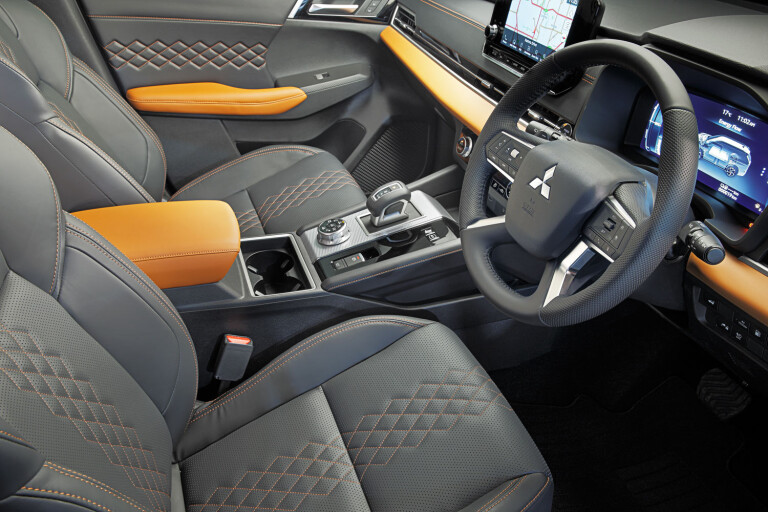
The infotainment system itself is also simple to navigate and there’s a USB-A and USB-C port ahead of the gearshifter. One minor annoyance? The wireless phone charging connection was frustratingly patchy, which is a niggle we’ve encountered in other Outlander models.
Interior space is adequate rather than ample. The front pews are roomy and comfortable but squeezing in a third row of seats means the Outlander’s second row and boot aren’t quite as spacious as other five-seat mid-size SUVs.
The seat itself slides, meaning you can vary the amount of rear room and boot space but even with the bench in its most rearward position, taller passengers may feel tight on knee room.
It’s not a dealbreaker – we’ve completed several long journeys in the rear seat and didn’t feel cramped – but there are other contenders in this segment with roomier cabins. And the Outlander’s 478L boot, while decent, is about 100L less than you get in a Toyota RAV4.

Still, at least buyers have the choice of seven seats this time around. The old PHEV was a five-seater only but clever packaging of the new rear electric motor, which is now around 50 per cent smaller, has liberated enough room to include the additional seats.
A few things worth pointing out? Erecting the third row is different to other Outlander models. In petrol variants, the two additional seats can be easily lifted up individually but in the PHEV it’s a four-step process that requires you to lift and flip both seats together. It’s a bit of a faff and the seats are surprisingly heavy.
Squeezing an electric motor onto the rear axle also means the PHEV has no spare tyre. Instead, you get a puncture repair kit that could be a dealbreaker for buyers that travel into remote areas.

What is it like to drive?
This is a vastly different SUV to drive compared with the rest of the Outlander range.
Where other Outlander models rely on a fairly average and unremarkable Nissan-sourced 2.5-litre naturally aspirated petrol engine paired with an automatic continuously variable transmission (CVT), the PHEV’s powertrain is considerably more polished, potent and sophisticated.
First impressions are that it feels more like a genuine EV to drive than a typical hybrid. Throttle response is instant and the level of available performance feels genuinely muscular low in the rev range, which makes it ideal for nipping into tight gaps in traffic.
Despite the complexity of pairing two electric motors with a petrol engine, it’s fuss-free, smooth and swift to operate. Not to mention silent.
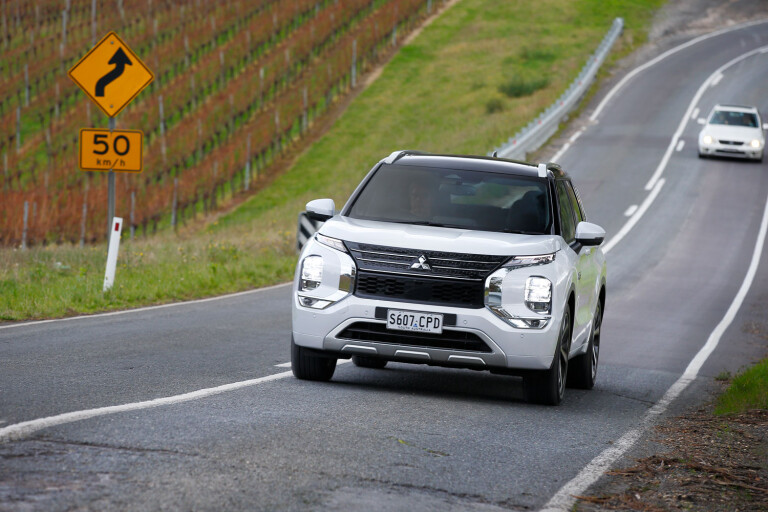
And unlike a Toyota hybrid that clunkily fires up the combustion engine if you add too much throttle, the Outlander can be driven as an EV with confidence. Much of that is down to how the hybrid system is calibrated.
Unlike most plug-in systems, which revert solely to petrol power once the battery pack is depleted, the Outlander always favours electricity to turn the axles. The petrol engine is used mostly as an on-board generator to top up the battery, meaning that in the majority of scenarios the driver benefits from instant throttle response and sprightly off-the-mark acceleration.
This set-up also means the handover between electric propulsion and petrol power is seamlessly integrated. Some plug-ins can feel clumsy and jerky when the petrol engine kicks in but the Outlander is impressively smooth.
Unlike a Toyota hybrid that clunkily fires up the combustion engine if you add too much throttle, the Outlander can be driven as an EV with confidence.

Its petrol engine is remarkably quiet, too. The 2.4-litre unit itself is quite old – it first debuted way back in the mid-2000s – but Mitsubishi’s engineers have worked hard to improve its refinement.
The result is a powertrain that isn’t only commendably civilised and efficient but one that’s equally eager and responsive. It can also seem quite complex once you start to explore the multitude of different settings and modes…
These are split three ways. The first concerns drive modes, where a new Power setting joins the usual suite of Eco, Tarmac, Gravel, Snow and Mud.
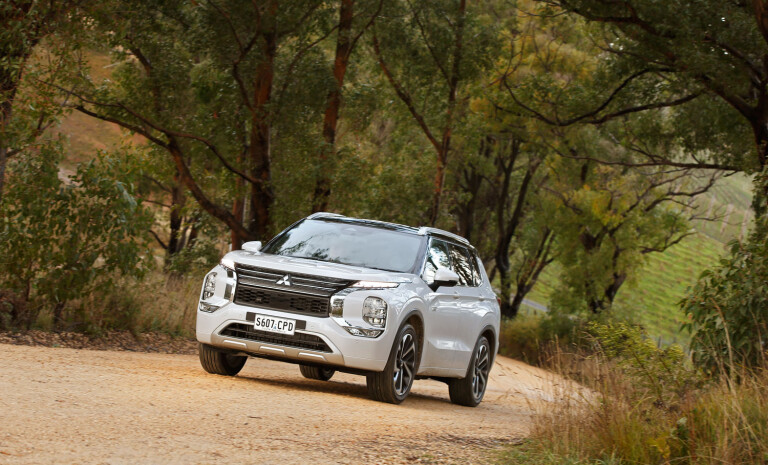
Power mode unlocks all of the PHEV’s powertrain performance and is needed to achieve its commendable 8.2-second 0-100km/h time. Without Power mode, that same dash is completed in just over 10 seconds, which is about the same as a petrol-powered Outlander.
The second suite of settings alters the behaviour of the battery. The default mode is Normal, which leaves the car to judge how best to deploy the battery and petrol engine.
EV mode ensures battery-only propulsion, even if the throttle is pressed to the firewall, while Save deploys the petrol engine to retain the amount of charge currently available in the battery.
Charge is the fourth mode and it uses the petrol engine to top up the battery while you’re on the move. Interestingly, Mitsubishi says the petrol engine takes around an hour to top the battery up from 0-80 per cent.
Power mode unlocks all of the PHEV’s powertrain performance and is needed to achieve its commendable 8.2-second 0-100km/h time.

Finally, you have six different stages of regenerative braking to play with. Five of these are explored by using the shift paddles behind the steering wheel. The left paddle adds more regen while the right paddle takes it away. It’s quite effective to use on the fly and this time around, the regenerative effect is twice as strong as on the original Outlander PHEV.
The sixth and heaviest regen mode is activated by pushing a button on the centre console. This deploys enough recuperation that one-pedal driving is possible in most situations, although the brake is still needed to bring the SUV to a complete stop.
Does all of that sound a little overwhelming? It can be at first, but after a few hours we found switching between the different powertrain and braking modes to be simple and intuitive, even while driving.
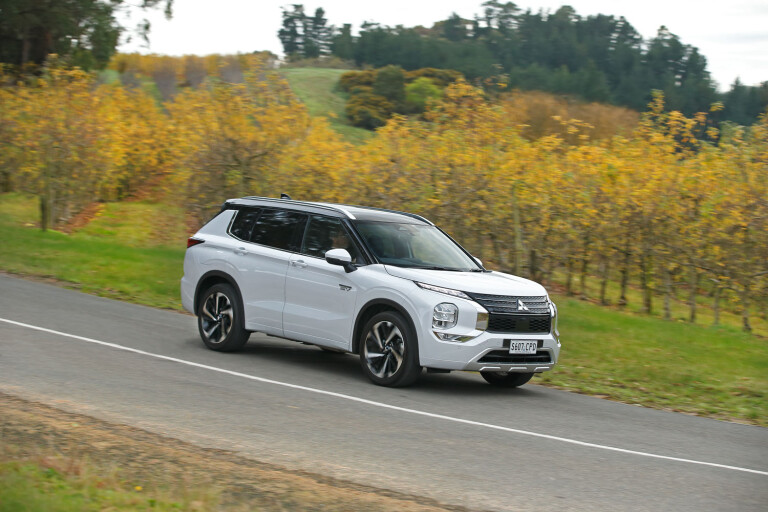
The rest of the PHEV’s ride and handling compromise is nicely judged. Adding the battery and two electric motors means the PHEV is around 340kg heavier than petrol models but deft chassis tuning and mounting most of that weight low in the chassis means it hides its additional mass remarkably well.
Body control is impressive and grip levels from models on 20-inch wheels is surprisingly high. Combine this with the instant low-down shove of the electrified powertrain and the PHEV is actually quite fun and composed to hustle up a twisty mountain road.
The brake pedal feels nice and natural too, with none of the corruption and travel inconsistency that can plague hybrid cars. There’s ample stopping power on offer too, thanks to larger discs that measure 350mm up front and 330mm out back.
Body control is impressive and grip levels from models on 20-inch wheels is surprisingly high.
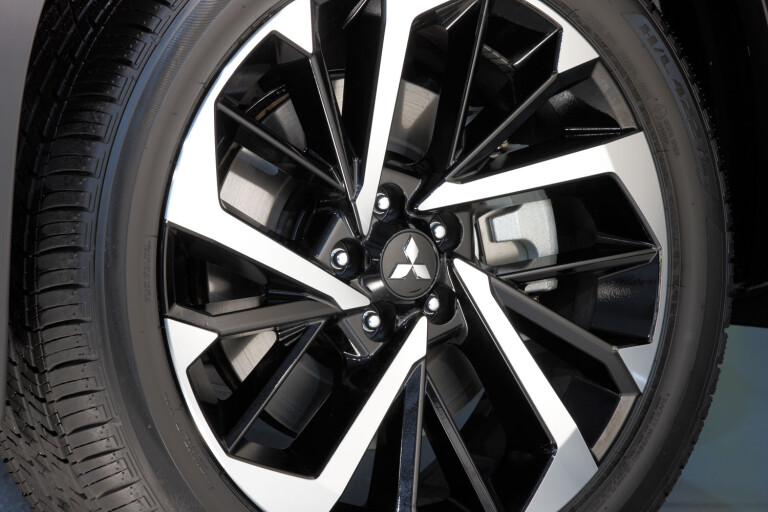
The ride mostly strikes a sweet balance between comfort and control, but just like the rest of the Outlander range, sharp bumps and surface imperfections can jolt unpleasantly through the cabin.
You feel bumps more keenly on the 20-inch wheels but, weirdly, the ES we drove on the 18-inch alloys didn’t deliver an appreciable improvement.
Another minor chassis criticism? The PHEV’s steering tune has been recalibrated and it now feels lighter on either side of the straight ahead. Not a dealbreaker in daily driving but during spirited driving, you do notice it feels a touch vague.
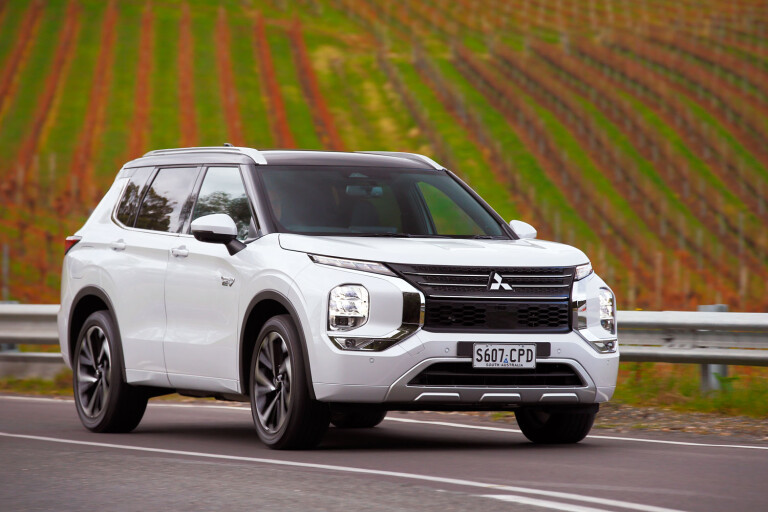
How is it on fuel?
Finally, we arrive at the PHEV’s strongest discipline. Officially Mitsubishi says the Outlander PHEV uses 1.5L of dinosaur juice per 100km.
That’s a huge improvement compared to the regular Outlander range, which has a combined fuel consumption figure of between 7.5L for front-drive variants and 8.1L for those with all-wheel drive.
Our real-world experience of driving an AWD Outlander Exceed has returned around 9.0L/100km.
But is 1.5L/100km actually achievable in the PHEV? Mostly that will come down to how you use it. Mitsubishi’s own research shows owners of the previous PHEV drive it in pure EV mode 84 per cent of the time, meaning that if your daily commute is less than 84km, the goal of drastically slashing your fuel bill should be an achievable one.

For reference, our consumption after a day of fairly rigorous driving averaged 2.0L/100km according to the trip computer.
Electricity consumption was 26kWh/100km, a little on the heavy side compared with many dedicated EVs.
Mitsubishi’s research also shows owners recharge the PHEV at home 99 per cent of the time and the majority plug it in once a day. On a regular 240V socket, the PHEV takes around 9.5 hours to achieve a full charge. Fitting a more powerful AC wallbox at home drops this to 6.5 hours.
The cables required for both forms of AC charging are included as standard across the PHEV range. DC fast charging is also available via a CHadeMo plug and allows a 0-80 per cent charge in 38 minutes.
How safe is it?
Just like the rest of the Outlander range, the PHEV carries a five-star ANCAP safety rating.
Standard safety equipment levels are high across all PHEV models and includes:
| AEB with pedestrian and cyclist detection |
| Emergency lane assist |
| Lane departure warning and prevention |
| Blind spot warning and intervention |
| Traffic sign recognition |
| Driver fatigue monitor |
| Adaptive cruise control |
| Eight airbags |
| Front and rear parking sensors |

Warranty and running costs
Worried that the PHEV’s complex powertrain means it’ll be expensive to maintain? Don’t be.
Service intervals are the same as the rest of the Outlander range at 12 months or 15,000km and 10 years of capped price servicing is available as a standard inclusion, too.
Minor services cost $299 while a major service ranges between $599 and $799.
Like all new Mitsubishis, the Outlander PHEV benefits from a market-leading 10-year factory-backed warranty, providing it’s serviced at an authorised dealer.
One key distinction? That battery pack in PHEV models carries a lesser warranty of eight years or 160,000km. Mitsubishi will also guarantee the battery against excessive degradation and will replace it if its useable capacity dips below 66 per cent over that eight-year period.
Still, that’s something to be mindful of. All batteries degrade and in eight years, your EV-only range could drop from 84km to 56km.
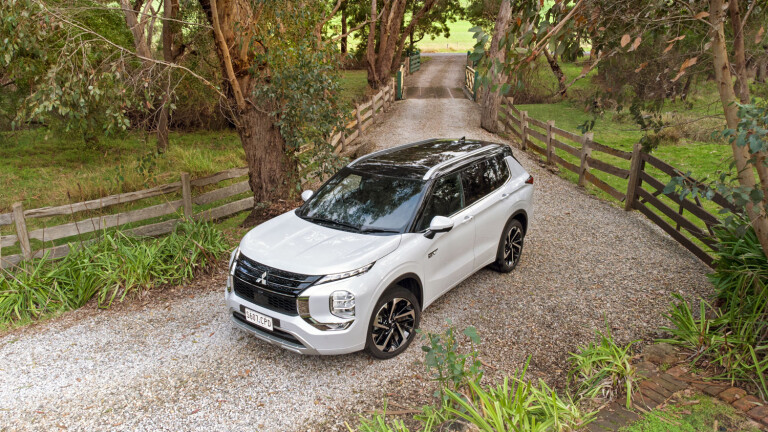
VERDICT
The second-generation PHEV is a convincing and appealing addition to the Outlander range. Its powertrain is superior to the existing 2.5-litre petrol and it not only drinks considerably less fuel but is smoother, quicker and quieter. The elephant in the room is the PHEV’s price premium.
If you’re buying a family SUV on cold hard numbers alone, it’ll take a long time for the PHEV to deliver a return on investment at the bowser alone. But the PHEV’s appeal stretches beyond its ability to use less fuel.
The powertrain feels more premium, it’s easier to drive in cut-and-thrust city traffic and unlike the old PHEV it carries no compromise in boot space, seating capacity or its ability to tow.
It also stacks up favourably against its plug-in rivals for price and performance, meaning it’s a tempting proposition if you’re interested in an electrified family SUV but aren’t quite ready to make the jump to a pure EV.
The second-generation PHEV is a convincing and appealing addition to the Outlander range. The elephant in the room is the PHEV’s price premium.
NEW, October 2022: Outlander PHEV long-termer arrives!
Inwood has transitioned out of the petrol Outlander and into a new Outlander PHEV. Get that long-term diary here.
2022 Mitsubishi Outlander PHEV Exceed specifications
| Body | 5-door, 7-seat SUV |
|---|---|
| Drive | All-wheel drive |
| Engine | 2360cc 4cyl DOHC 16v |
| Compression | 12.0:1 |
| Bore/stroke | 88 x 97mm |
| Power | 185kW |
| Torque | 450Nm |
| 0-100km/h | 8.2sec claimed |
| Transmission | Single-speed reducation |
| Weight | 2144kg |
| Fuel consumption | 1.5L/100km |
| Front suspension | MacPherson strut |
| Rear suspension | Multi-links |
| L/W/H | 4710/1862/1745 |
| Wheelbase | 2706mm |
| Brakes | 350mm discs (f); 330mm discs (r) |
| Tyres | 255/45 R20 |
| Wheels | 20 X 8J |
| Price | $68,490 |
Score breakdown
Things we like
- Boosted EV-only range
- No compromise on boot space or towing ability
- Efficiency gains over petrol Outlander
- Polished and sophisticated powertrain
Not so much
- Price premium over petrol versions
- Ride can feel harsh over sharp bumps
- No spare tyre



COMMENTS